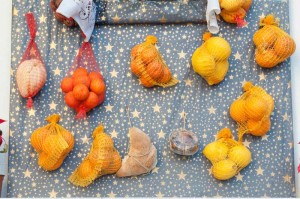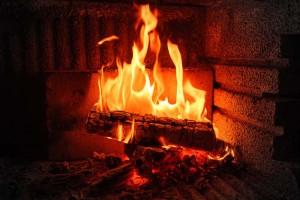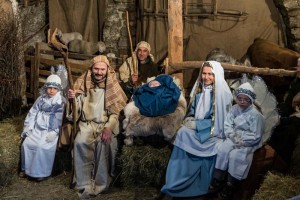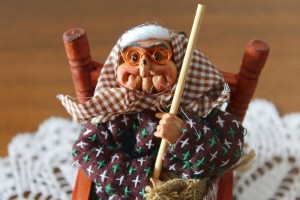All festivities have their customs and traditions. This also – and in particular – applies for Christmas. Italians celebrate four times before, during and after the holidays. Some customs exist in the entire country; others are specific to certain regions or cities. Several different festivities are strung together between December 6th and January 6th. Learn more about Italian Christmas customs and the different holidays here.
San Nicola on December 6th
As opposed to many other, particularly German-speaking countries, St Nicholas’ Day carries comparatively little meaning in Italy even though it marks the start of Advent. San Nicola is traditionally celebrated on December 6th. Parents surprise their children with small presents and sweets. As the festival of Santa Lucia already takes place one week later, all Nicholas’ celebrations are fairly limited.
Santa Lucia on December 13th

©Bigstock.com/siculodoc
In 300 BC, a very young woman living in Syracuse on Sicily called Lucia was supposed to get married, but delayed the wedding because she wanted to dedicate her life to God and instead established an institution for the poor and sick. December 13th is the feast day of the saint, who was executed because of her marriage refusal. Children look forward to small gifts waiting on window sills or in shoes on the day of the carrier of light. The dessert Torrone dei poveri made from sugar and chick peas commemorates Santa Lucia in Sicily.
How Christmas is celebrated in Italy
For a long time, December 24th carried little meaning in Italy. The day only gained considerable importance in recent years. No meat is served for religious reasons; the dinner menu instead consists of different fish dishes combined with pasta and vegetables. Afterwards, many Italians play the bingo-like tombola. The time for opening presents is different from family to family. According to tradition, all unwrapping happens on the morning of December 25th. However, gift-giving increasingly takes place after the evening feast on December 24th. Nativity set and/or Christmas tree have already been set up on December 8th, Immacolata Concezione. Christmas Day, December 25th, is celebrated with an extensive lunch feast. Several courses with soups, meat, pasta, desserts and fitting wines promise constant indulgence. While December 26th is a holiday as well, it’s mostly used for visiting family and friends.
Characteristic Italian Christmas customs
Beyond this general subdivision, there are many more customs to be found in individual cities and regions. Your ZAINOO Italy experts have compiled a few peculiarities and traditions for you.
Ceppo di Natale

©Bigstock.com/First one stock
A widespread Italian custom sees the ceremonial burning of a hallowed piece of wood in the fireplace. Ceppo di Natale, also known as Christmas block or Yule log, is sprinkled with wine by the patriarch while saying a prayer in Lombardy. More often than not, Panettone is eaten with this custom. Three pieces are cut off the cake and one is left over to secure good fortune and health for the following year.
Cesenatico’s sea of light
The roots of the nativity set lie in Italy. It comes as no surprise that many traditions and customs are all about wooden figurines and displays of all sorts. Cesenatico at the coast of the Adriatic Sea in Emilia-Romagna sends old fishing boats of the local museum into the waters. When the dark of night covers the region in Christmas, bright lights shine upon the figurines of the Holy Family carved from wood.
Companions of Infant Jesus
The divine infant finds companionship in rather unusual characters in Sicily. A pizza baker, a pastor with a wine glass and an innkeeper, and orange- and lemon trees assemble around Bambino Gesù representing the jovial, colourful joie de vivre of the island.
The live nativity scene of Alberobello

©Bigstock.com/isaac74
Italy’s nativity sets have a long-standing tradition. Some families even argue over whether they should place a Christmas tree or a nativity set in their home. It hardly comes as a surprise that there are numerous live nativity scenes throughout the country with its most famous version located in Alberobello, home of the Trulli, in Apulia. The three Magi, accompanied by shepherds, bands and costumed groups, process to the church square, where the Holy Family is already waiting in a live nativity scene.
La Befana on January 6th

©Bigstock.com/Riccardofe69
The fourth and final part of the Italian Christmas festivities takes part on January 6th or Twelfth Day when the witch La Befana rides her broomstick across the roofs. Good children receive gifts, naughty children wake up next to small pieces of coal. According to lore, the three Magi knocked on Befana’s door and asked her to come with them to Bethlehem. The witch, however, wanted to finish her weaving first and followed later. She missed the star of Bethlehem and has been straying across the world looking for Infant Jesus ever since. January 6th is accompanied by many small festivals, events and attractions for children and is widely regarded as one of the most important, most beautiful family days of the year.
The approximately month-long Christmas festivities in Italy are an experience for all ages between contemplativeness and exuberance. Every place, every family has its own customs and traditions, special gift ideas and menus. Experience Christmas in Italy in all of its glory with the ZAINOO travel suggestions!